Search Results
50 years of service: BART could have been an elevated monorail and other fascinating facts from the Parsons-Brinckerhoff report
A rendering of a “basic supported system” train from the Parsons-Brinckerhoff report of 1956. In celebration of BART’s 50th anniversary this year, we’re looking back at the transit system’s five decades of service and innovation in a new series of stories. BART celebrates 50 years on Sept. 11, 2022. Deep in
Hear from a panel of experts about a 2026 transportation ballot measure at BART Board Workshop
The BART Board of Directors annual workshop will be held Thursday, February 8, 2024, and for the first time, it will include a lively panel discussion with transit advocates, policy experts, and key stakeholders to discuss what is needed to develop and successfully pass a regional transportation funding measure to provide long-term funding for BART and all Bay Area transit agencies.
The panel discussion is free and open to the public and will take place from 9am-noon in the BART boardroom (2150 Webster Street, Oakland) and on Zoom. This is an exciting opportunity for the BART board, BART employees, news media, and members of the public to hear a variety of perspectives about what transit operators need to do in the next 30 months to achieve a successful transportation measure in 2026, including improvements to the customer experience and policy reforms.
In addition to the experts on the panel, Rebecca Long from the Metropolitan Transportation Commission will help us set the stage for the discussion, as they are leading the effort to secure long term funding for transit.
Public comment related to the panel topic will be taken at the end of the panel discussion.
The second half of the Board Workshop will include informational staff presentations on BART’s operating budget projections and BART’s capital program to fund and deliver projects that ensure safe, reliable, and frequent service. Staff will also introduce a new customer commitment and review the changes underway to improve the customer experience.
View the agenda and presentations.
Panel Details
Moderator: Karen Philbrick, PhD, Mineta Transportation Institute, San Jose State University
Panelists:
• Alicia John-Baptiste, President and CEO, SPUR
• Darrell Owens, Policy and Data Analyst and Advocate, East Bay Transit Riders Union
• Emily Loper, Vice President of Public Policy, Bay Area Council
• Ian Griffiths, Co-Founder and Policy Director, Seamless Bay Area
• Jeff Shaffer, President/Business Agent, Local 1277, Amalgamated Transit Union (ATU)
When: February 8th, 9am-noon
Where: In person in the BART Boardroom, 2150 Webster Street, Oakland, or via Zoom by calling
833-548-0282 and entering access code 822 5984 8450 or logging in to Zoom.com and entering
access code 822 5984 8450.
On Jan. 1, BART fares to increase 5.5%, low-income fare discount to increase to 50%
A modest fare increase and a deeper discount on fares for qualifying lower-income riders will both go into effect on Monday, January 1, 2024.
The Clipper START means-based fare discount for BART will increase from 20% to 50%, meaning low-income riders will pay half the regular fare. The Metropolitan Transportation Commission pilot program offers discounts for Bay Area residents aged 19-64 earning under 200% of the federal poverty level. Clipper START is accepted by more than 20 regional transit operators in addition to BART.
Fares will increase by 5.5% beginning January 1, raising the average fare by 23 cents to $4.43. A 12-mile trip from Downtown Berkeley to Embarcadero, for example, will increase by 25 cents to $4.75. For a 45-mile trip from Antioch to Montgomery Street, the fare will increase by 40 cents to $8.60.
The fare increase was approved by BART’s Board of Directors during the June 8, 2023, budget vote. The Board decided to deviate from its policy of approving a fare increase every two years. BART’s Inflation-Based Fare Increase Program, which has been in place since 2003, would have required an 11% fare increase in January 2024. To cushion the economic impact on riders, the Board directed staff to instead raise fares 5.5% in January 2024 and again at the same rate in January 2025.
BART’s Trip Planner and online Fare Calculator have been updated with the new fares. Riders can look up their new fare by selecting a date of January 1, 2024, or beyond. New fare chart decals will be posted at vending machines.
Fares Fund Operations
The fare increases are expected to bring in an additional $26 million in operating funds through FY25.
Historically, BART relies on rider fares to fund safe, reliable, and clean service – more so than most other transit systems. This requires small but frequent fare increases to keep up with the cost of inflation.
New Fare Gates Being Deployed
Because our riders are directly responsible for funding our operations, BART is rolling out new fare gates in 2024 to protect against fare evasion and self-enforce fare payments.
Low-Income Riders Will Pay Less in 2024
Even with the fare increase, low-income riders will pay less for BART because the Clipper START discount is being increased to 50%.
BART Discounts
- Youth 5-18 years old get 50% off with a Youth Clipper card.
- Seniors 65 and over get 62.5% off with a Senior Clipper card.
- Low-income riders get 50% off starting Jan. 1, 2024, through the regional Clipper START program, available to adult riders earning 200% or less of the federal poverty level.
- The RTC Clipper card is a version of Clipper created for passengers under 65 with qualifying disabilities for 62.5% off fares.
- BART offers a “High-Value Discount.” Adult Clipper cards get a 6.25% discount on cash value rides by buying $48 worth of value for $45 or $64 worth of value for $60 when autoload is set up.
Not One More Girl safety events planned at two BART stations 9/28 and 10/5
BART officials will be joined by community partners at two safety events as part of the Not One More Girl initiative to educate riders about safe bystander intervention tactics and preventing sexual harassment on BART.
Event Details
- Thursday, September 28, 2023, at Downtown Berkeley BART Station from 12pm-3pm. View the Flyer.
- Thursday, October 5, 2023, at Lake Merritt BART Station from 12pm-3pm. View the Flyer.
The Not One More Girl team will host these "Bystander Safety Zone" events to hand out our new bystander intervention safety cards and other informational material from the campaign, while speaking to riders about tangible things we all can do to make BART safer for youth.
Not One More Girl is a BIPOC youth-led initiative in partnership with community-based organizations and BART to end gender-based violence. Phase II of the campaign launched last month.
- View a PDF of the "I Got You" bystander intervention card.
- View a PDF of the "You Got Me?" bystander intervention card.
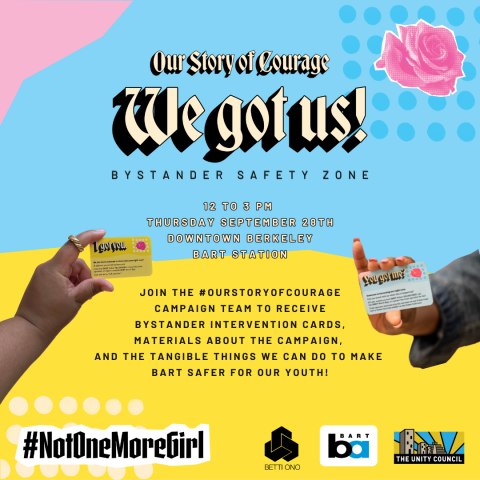
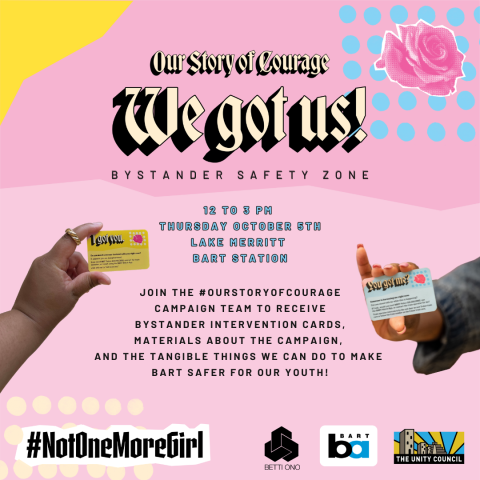
Bystander Intervention Cards for Riders
Two distinct wallet-size cards are now available to riders to discreetly hand to people to signal they need help or support, or to notify someone being harassed that you are there to help and support them.
These new bystander intervention cards are a concept developed by the youth design team, who expressed the need for options when asking for help or approaching a situation of potential harm. The cards include the slogans “I Got You” and “You Got Me?” with a list of actionable items riders can take to help a situation, from reporting the harassment to simply standing with someone. As young people are still trying to find their voices and figuring out how to navigate and decipher harassment, a physical card you can hand someone is an effective tool to precipitate the shift from being a bystander to becoming an agent of change.
The cards are available for pick up at each Station Agent booth at BART, and Ambassadors and Crisis Intervention Specialists will carry the cards and give them out when engaging riders. BART and the Betti Ono Foundation will also work to distribute the cards to youth through community organizations, events, and schools.
BART's Mark Nagales honored his grandmother’s memory with one final trip on a legacy train
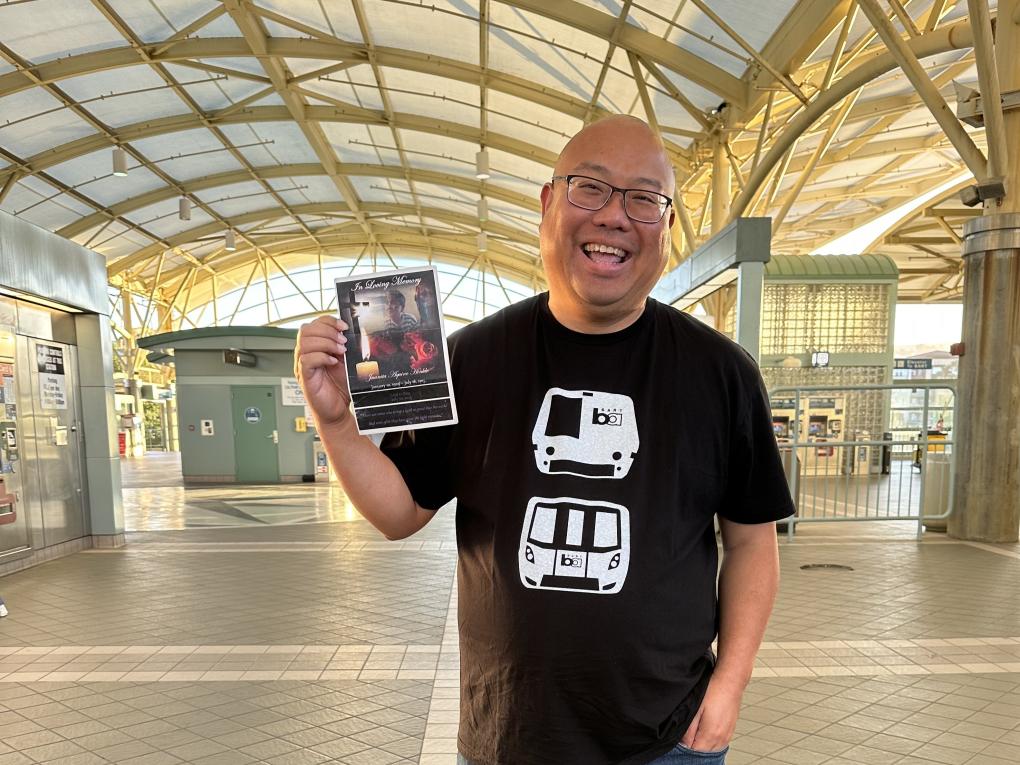
Mark Nagales is pictured at Millbrae Station with the program from his grandmother's 2015 memorial service.
Mark Nagales’s earliest childhood memory is riding a BART train with his grandmother. He can recall the colors most of all – the blue seats, golden carpet, all the ads and people and scenery streaming by the giant windows.
“Growing up, everything in my house was white, so it stuck out to me how vibrant the BART trains were. I’ll never forget the colors of those legacy trains,” said Mark, who joined BART in 2023 as a Senior Government and Community Relations Representative.
Every weekend for years, preschooler Mark and his grandmother, Juanita, would take BART from their home in South San Francisco in search of adventure. Often that meant simply riding the Yellow Line an hour or so from South San Francisco Station to Concord.
“We didn’t have a lot of money, so going to Concord to see relatives was like a vacation,” Mark said. “I didn’t get out of the sphere of South San Francisco often, so looking out the windows on BART, I was wide-eyed. I’d never seen so many places before. It was like traveling to a new world.”
On BART days, Mark remembers waking up early with his grandma and going to McDonald’s for a 20-piece McNuggets meal – a quick snack before they walked to the station and caught a train. Grandma Juanita didn't like driving outside of her small neighborhood, “but she always felt comfortable on BART,” Mark said.
Onboard, Mark stayed glued to the windows, his hands and nose leaving tiny streaks on the glass. He admits that he sometimes had trouble sitting still onboard – there was just so much going on, so much to see! Grandma Juanita didn’t mind the high energy.
“She just loved that I was happy,” Mark said. “And she loved that I was with her.”
When Mark learned the last in-service legacy train would be taking its final ride on Sept. 10, 2023, (BART officially retired the legacy fleet at a celebration in April 2024), he knew he had to be on that train. And he knew he had to bring his grandmother, who passed away in 2015, with him.
So Mark gathered his wife and two children, and together, they rode the old BART train into San Francisco. During the ride, he held the program from his grandmother’s memorial service.
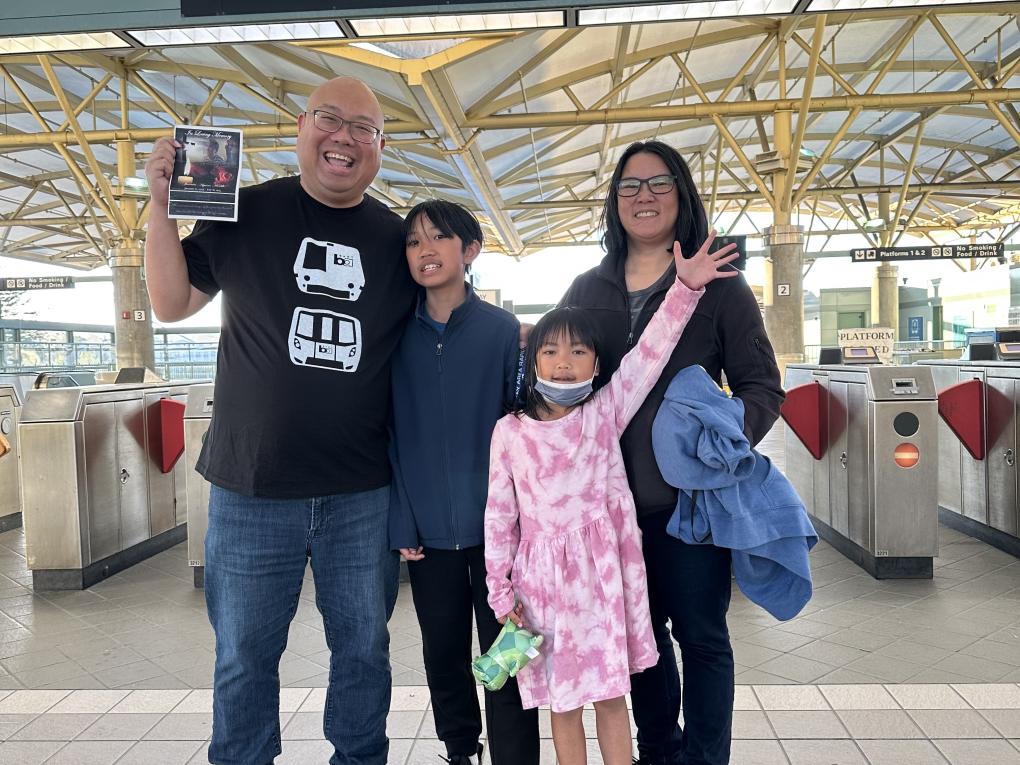
Mark Nagales and his family pose on the concourse at Millbrae Station.
“It was a full circle moment for me,” he said. “That ride was a way to say thank you to my grandmother and to honor her memory.”
That legacy train ride was something of a transit party with lots of people taking photos, shaking hands, and swapping their favorite BART memories tied to these old trains.
Mark expected the experience to be a bit emotionally challenging, but once the ride began, it was nothing but celebration and good cheer.
“I couldn’t stop smiling because I just kept thinking about my grandma and how proud she’d be if she could see me now. And the best part was that I was able to experience it with my own family.”
Mark immigrated from the Philippines to South San Francisco when he was one year old. Many of his earliest memories revolve around his grandmother, who took care of him when his parents were working multiple jobs at San Francisco International Airport. It was rare for Mark to have both his mom and dad home at the same time.
“The constant in my life was my grandma,” Mark said. “She taught me how to be loving, caring, and kind because that’s how she treated me.”
At one point, Grandma Juanita took a part-time job at the airport. She didn’t have to work, but wanted to in order to make sure her grandson could have everything he might need.
"We didn’t have much back then,” Mark explained. “But love was always abundant.”
Mark is the first person in his family to not to work at SFO. He nonetheless honors his family’s transportation lineage through his work at BART. When he received the official offer letter, Mark said all he could think about was being five years old, holding his grandmother’s hand on BART.
“To be able to work at the transit agency that opened the world to me...there are no words,” he said. “When I started working here, it felt like home. It made me think about all the things my grandma and family experienced and all the families who are currently experiencing the same things. I know BART is making a difference for them like it did for us.”
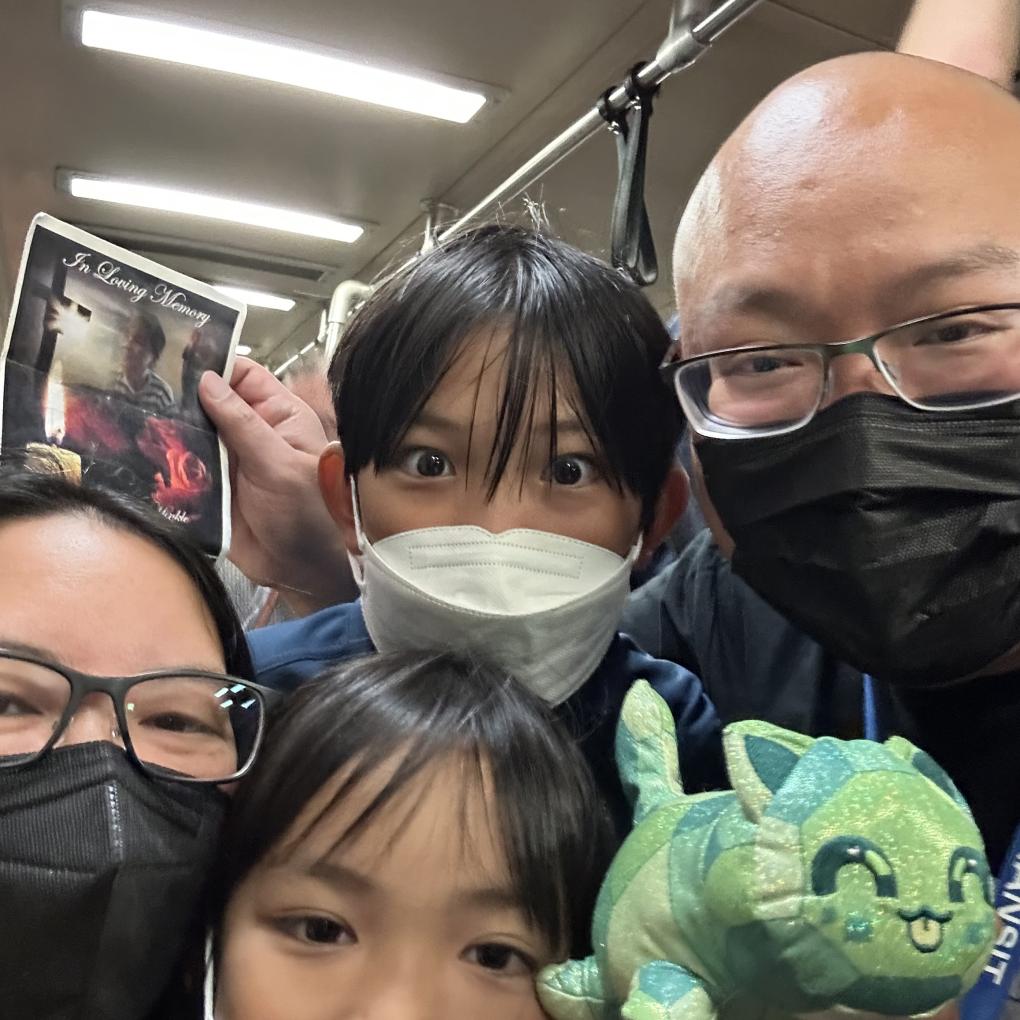
Mark Nagales and his family pose for a selfie on a legacy BART train.
Mark and his family still live in South San Francisco and even serves on the city council. His parents are just a few minutes down the road, and like Grandma Juanita, Mark’s mom loves to spend time with his eight-year-old daughter, Josephine, to take her around the Bay on BART.
Now that he has children of his own, Mark gets to experience the same feelings his grandmother experienced when she got to watch him play and learn and grow.
“When you’re a kid, you don’t realize how happy it makes your parents or grandparents see you experience joy,” he said. “When my kids get to be my age, they’ll look back like I’m doing now and realize how much these special moments meant to their dad.”
Mark’s final ride on the legacy train was one such special moment, and to share it with his beloved Grandma Juanita and his own family meant everything to him.
And it turns out the apple doesn’t fall far from the tree.
“On the train, my kids do exactly what I used to do -- putting their hands on the windows, playing around on the seats. I’m always like, ‘Don’t do that!’” Mark said. “You know, I bet my grandma once said the same thing to me.”
BART offering special early service with limited stops for 2025 Bay to Breakers (May 18)
BART will provide four trains with limited stops before regular BART service begins for Bay to Breakers on Sunday, May 18, 2025. The special service will get race participants to Embarcadero around 7am.
The special early morning trains will pick up passengers for an Embarcadero arrival with limited service from the following stations: 16th St. Mission, Bay Fair, Daly City, El Cerrito del Norte, Dublin/Pleasanton, MacArthur, Millbrae, Pleasant Hill/City Center, and West Oakland.
These four trains will go out of service once they drop riders off at Embarcadero. Riders cannot board a train at Embarcadero.
Caltrain will be running two limited-stop, pre-race trains to San Francisco that will arrive before the start of the race (more info here), and SF Muni is providing pre- and post-race express service on several rail lines and bus routes (more info here).
Plan your trip using the BART Trip Planner.
Special Service Details
One train will leave Millbrae at 6:30am, Daly City at 6:42am, 16th St./Mission at 6:52am, and then arrive at Embarcadero at 6:57am. No other stops will be made along the line.
A second train will leave Pleasant Hill/Contra Costa Centre at 6:23am, MacArthur at 6:43am, West Oakland at 6:52am, and then arrive at Embarcadero at 6:58am. No other stops will be made along the line.
A third train will leave Dublin/Pleasanton at 6:18am, Bay Fair at 6:35am, West Oakland at 6:56am, and arrive at Embarcadero at 7:01am. No other stops will be made along the line.
A fourth train will leave El Cerrito del Norte at 6:34am, MacArthur at 6:47am, West Oakland at 6:56am, and arrive at Embarcadero at 7:02am. No other stops will be made along the line.
Regular systemwide BART service starts at around 8am.
Tips
BART parking is free on Sundays. People driving to BART to take the train should park at one of these stations being served: Pleasant Hill, El Cerrito del Norte, MacArthur, Bay Fair, West Oakland, Daly City, Dublin/Pleasanton, and Millbrae. 16th Street Mission does not have a BART parking lot.
BART has loaded these event trains as special service into BART Trip Planner. The service is demarcated with "-> Limited Stop to Embarcadero" in the planner.
Once on the platform, these four trains will be labelled as: “Limited Stop to Embarcadero.”
Load your Clipper card in advance with enough funds for your full trip.
If you don’t have a Clipper card, add one for free ($3 savings) to your phone’s wallet in advance and use Google Pay or Apple Pay.
*This article was posted on April 30, 2025.
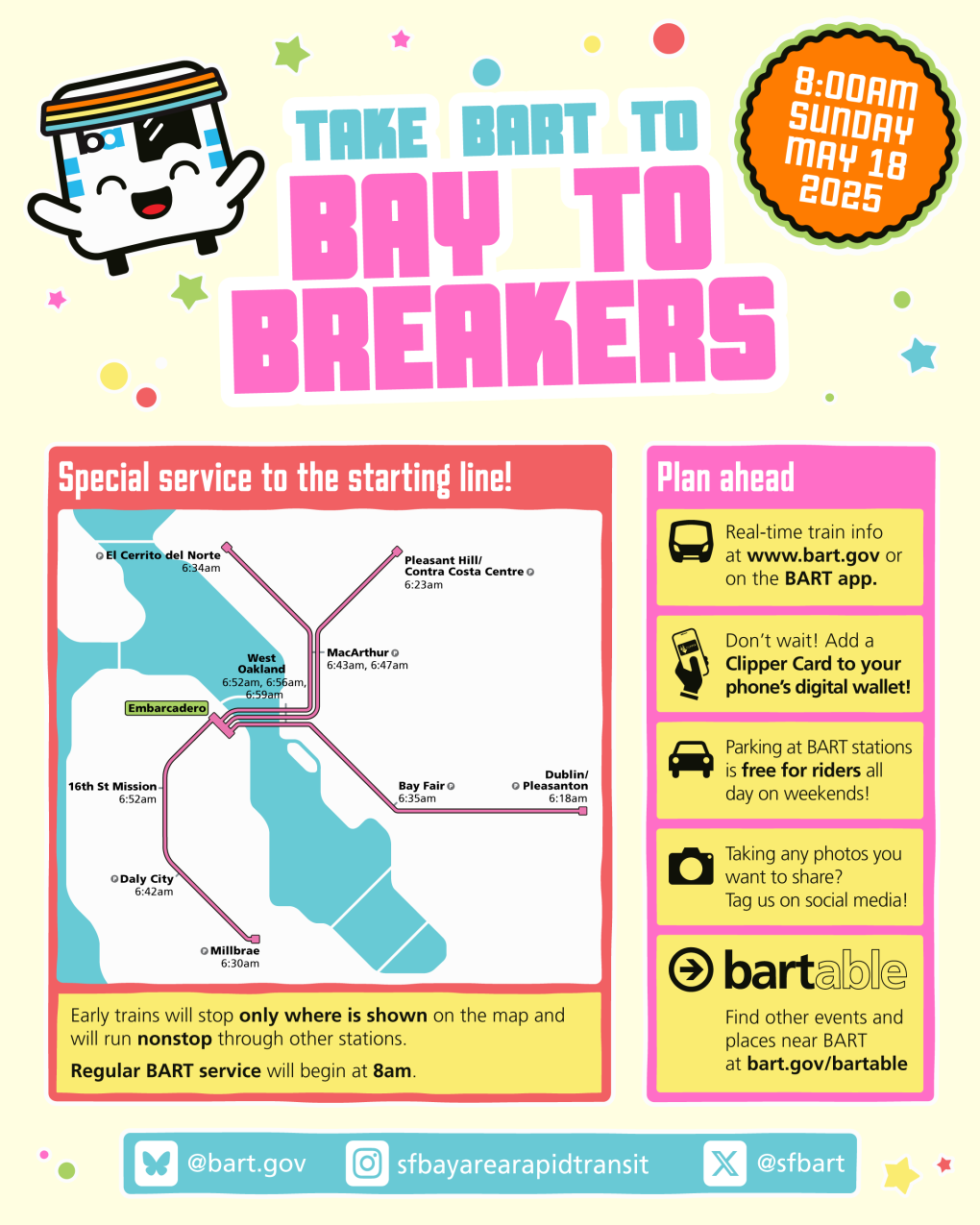
BART celebrates installation of Next Generation Fare Gates in all San Mateo County stations
BART’s work to install state-of-the-art Next Generation Fare Gates at all 50 of its stations by the end of this year has achieved a significant goal. With the recent completion of work at San Bruno Station, new gates have now been installed at all six BART stations in San Mateo County. Next Generation Fare Gates are now in service at 48 stations, putting the project on track to reach its goal of full installation across the five counties BART serves by the end of 2025.
“The installation of these game-changing fare gates is the result of a collaborative effort. I’m proud to say we have hit the reset button on the relationship between San Mateo County and BART,” said San Mateo County Board of Supervisors President David Canepa. “BART and San Mateo County share the goal of increasing ridership through making stations safer and cleaner. These gates represent a critical step in what will be an ongoing partnership to put riders first.”
Next Generation Fare Gates feature clear swing barriers that are much more difficult to push through or jump over compared to the old gates BART had used for decades. The new gates are bolstered by a one-of-its-kind locking mechanism designed to boost their resilience. The gates also improve access for paying riders. They have LED lighting on the swing barriers and are equipped with 3D sensors that can detect if someone is in a wheelchair or has a bike, stroller, or luggage with them.
“We carry approximately 25 percent of transit boardings among all operators in San Mateo County,” said BART General Manager Bob Powers. “I think even more people in San Mateo County will ride BART because of these fare gates and how they are changing the station environment by serving as a deterrent against unwanted behavior.”
The new gates are getting mostly positive reviews from riders. A survey of riders indicated the number of those who reported seeing someone fare evade dropped by nearly 1/3 from just a year ago as new gates have been installed in more stations.
The installation of Next Generation Fare Gates at the five non-airport stations in San Mateo County was fully funded by the San Mateo County Transportation Authority through voter-approved Measure W. SFO funded the new gates at San Francisco International Airport Station.
Learn more about the Next Generation Fare Gates project here.
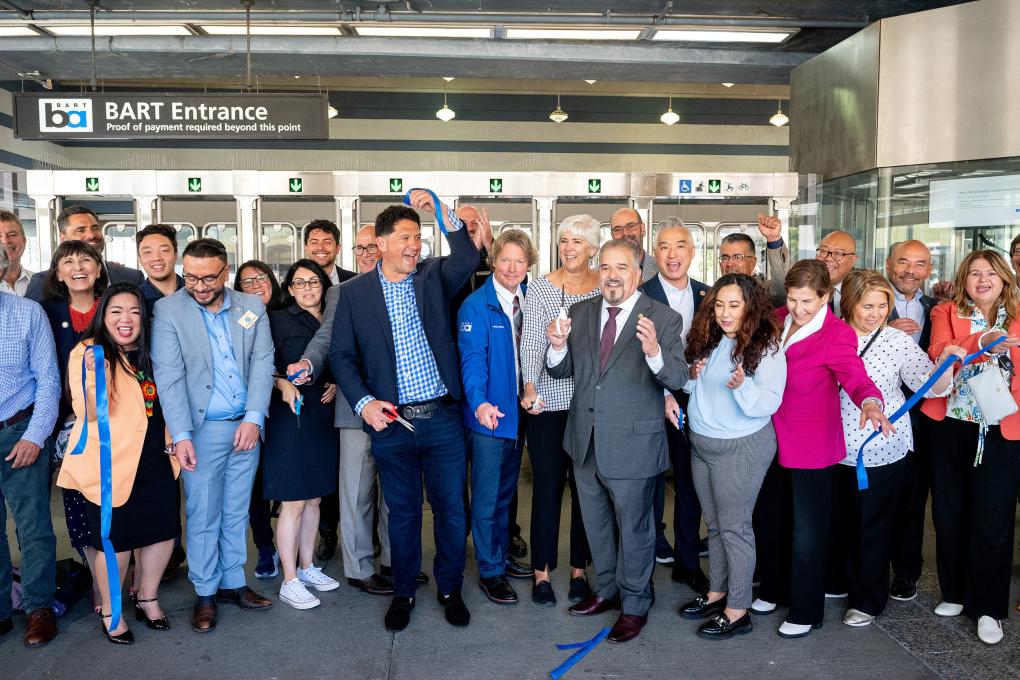
BART launches second online open house for El Cerrito-Berkeley Corridor Access Plan through 5/18/22
BART is launching its second online open house and survey to seek community feedback for future access strategies to and from BART along the corridor between El Cerrito Plaza and Ashby stations. This event opens Wednesday, April 20 at https://bartberkeleyelcerritocap.participate.online/. This is an important
BART’s schedule changed on January 13, 2025, to launch construction of a modern train control system
On January 13, 2025, BART will make schedule changes to accommodate the launch of construction to replace BART’s aged train control system with a modern Communications Based Train Control System.
The schedule change is happening in coordination with the region’s other transit systems as part of a collective effort to sync schedules, reduce impacts, and improve transfers for transit riders in the Bay Area.
Minor Adjustments
Overall, some departure times will shift by a few minutes, and we encourage riders to check the schedule before January 13, 2025, to see if their trip is impacted.
The BART Trip Planner has been updated with the new schedule so riders can start planning their trips using the date January 13, 2025, and beyond. PDF timetables have also been posted.
Late Night Construction between Colma and Millbrae for New Train Control System
Crews will be working on the track between Colma and Millbrae nightly after 9pm to upgrade our train control system. To reduce delays from this work, the Yellow Line will terminate at SFO instead of Millbrae to provide the resiliency our system needs to keep trains running on time and as optimally as possible in this section of track during the construction.
Late Night Changes for Millbrae Riders
After 9pm, Millbrae station will be served by a train that will run every 15 minutes between Millbrae and SFO only and riders will have an easy cross platform transfer at SFO to board a Yellow Line train to finish their trip.
At Millbrae, two of the four trains each hour will be timed with Caltrain’s 30-minute service schedule to provide a good transfer between Caltrain and BART.
As previously noted, after Red Line service ends each night, Yellow Line trains will terminate at SFO instead of Millbrae. Once at SFO, riders heading to Millbrae will cross the platform to board the Millbrae train, it will be labeled as a Yellow Line train to Millbrae.
However, after midnight, the final four Yellow Line trains to SFO station will proceed to Millbrae (riders will not need to transfer for Millbrae service), similar to the current schedule. The final train of the evening will bypass SFO, as it always does, and go straight to Millbrae. This is consistent with the current schedule.
These late evening changes will be displayed in the PDF timetable and in the Trip Planner to guide riders. And the official BART system map online, and posted at stations, will indicate a change in trains is necessary between 9pm-midnight.
This nightly service plan for Millbrae riders is expected to last several years as BART has prioritized this section of track to be the first area to bring on Communications Based Train Control (CBTC) in the BART system. The state-of-the-art CBTC system will transform BART service by enabling trains to run closer together and by updating aged equipment. A modernized train control system will enable BART to increase projected Transbay capacity to 30-trains per hour per direction in the core system area, from the current limitation of 24-trains per hour per direction.
Transit Coordination – The Big Sync
Bay Area transit agencies are now syncing schedules in a whole new way with a focus on improving transfers between systems and making schedule changes at the same time.
Most Bay Area transit agencies are rolling out new schedules in mid-January in coordination with each other and have now aligned the timing of schedule changes twice each year, once in summer (mid-August) and once in winter (mid-January). Since 2022, the number of transit agencies with full schedule change alignment (changing schedules at the same time August and January) has increased from 4 to 20, for a 400% increase.
Advancing schedule change alignment is a key priority for Bay Area transit general managers who meet on a weekly basis to make transit more rider-focused and efficient.
BART System Map for January 13, 2025 Schedule Change
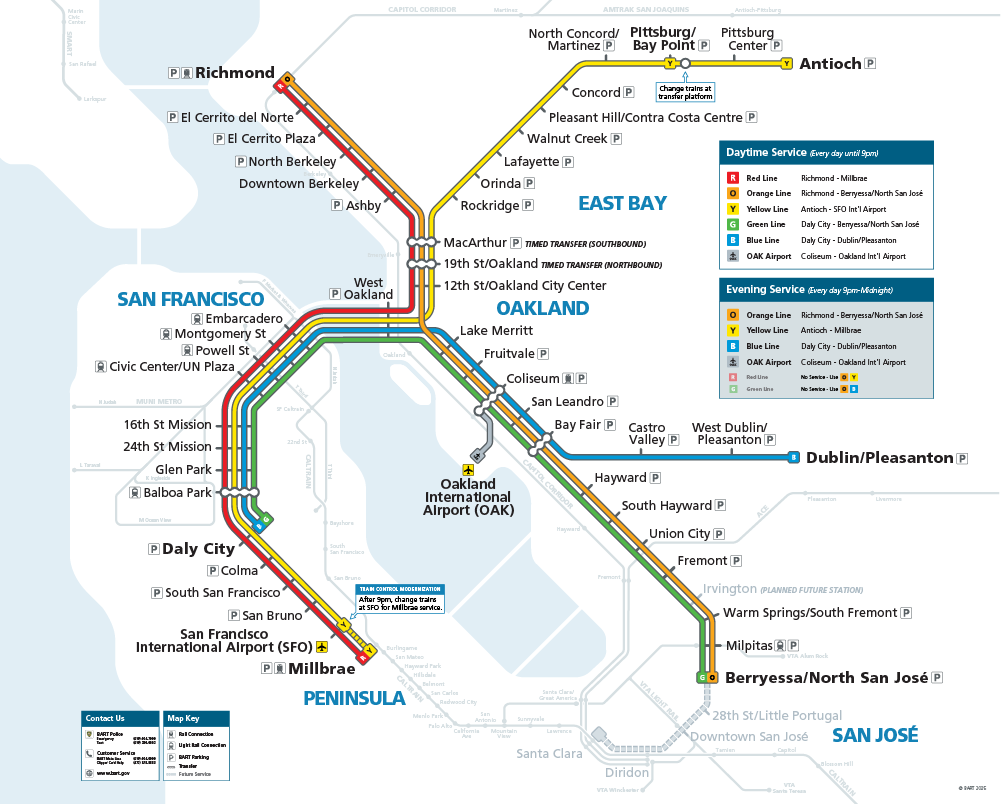
BART to reduce some Early Bird Express Bus trips starting August 12, 2024
BART offers alternative bus service called the Early Bird Express for weekday service before BART opens.
Due to low bus ridership on several routes, limited funding, and increasing demand for bus drivers from partner agencies, BART will make a series of service reductions to the Early Bird Express service in 2024. BART will retain eight trips that serve 90% of riders and will eliminate seven trips, impacting 10% of riders.
The changes will impact fewer than 20 riders.
The first change occurred on April 28, 2024 and June 16, 2024 and then again on August 12, 2024.
The full details of service changes, maps, and suggested alternatives can be found on the Early Bird Express page.
BART and partner bus agencies will do targeted outreach about these upcoming changes.
*This article was originally posted on March 13, 2024 and is being kept up to date.